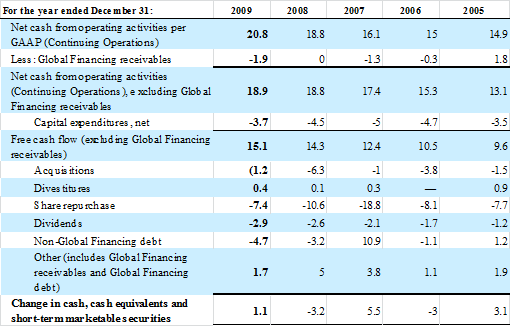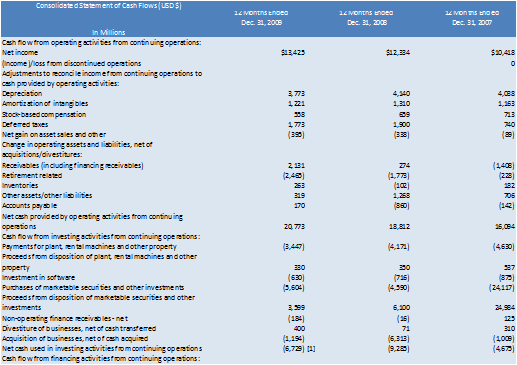7.12
Application Using Financial Statements
Estimating FCFE for Valuation Purposes:
Step 1:
Work through how FCFF and
FCFE is estimated by management and analysts.
Step 2: Estimate the growth behavior for a firm's FCFE.
Step 3: Estimate the discount
rate.
First we start with the
concept of Free Cash Flows (to the firm) and then we will break
this down into free cash flow to equity so we can value the
firm’s stock.
Data for IBM
In their 2009 10-K annual report Part 2, Item 7 (MD&A) IBM provided some selected discussion of free cash flows followed by a table comparing across years:
“Management uses a free cash
flow measure to evaluate the company’s operating results, plan
share repurchase levels, evaluate strategic investments and
assess the company’s ability and need to incur and service debt.
Free cash flow is not a defined term under U.S. GAAP and it
should not be inferred that the entire free cash flow amount is
available for discretionary expenditures. The company defines
free cash flow as net cash from operating activities less the
change in Global Financing receivables and net capital
expenditures. As discussed on page 24, a key objective of the
Global Financing business is to generate strong returns on
equity.
From the
perspective of how management views cash flow, in 2009, free
cash flow was $15.1 billion, an increase of $0.8 billion
compared to 2008. This cash performance was driven primarily by
the growth in net income of $1.1 billion, lower capital spending
of $0.8 billion and higher cash from sales cycle working capital
($1.2 billion), partially offset by higher retirement-related
funding ($0.9 billion) and workforce rebalancing payments ($0.6
billion).
Over the
past five years, the company generated over $61 billion in free
cash flow. During that period, the company invested $13.8
billion in strategic acquisitions and returned over $63 billion
to shareholders through dividends and share repurchases. The
amount of prospective returns to shareholders in the form of
dividends and share repurchases will vary based upon several
factors including each year’s operating results, capital
expenditure requirements, research and development investments
and acquisitions, as well as the factors discussed below.”

This can be
contrasted to their traditional Consolidated Statement of Cash
flows constructed earlier from the Excel Workbook exported from
the SEC site.

In the next
section we will reconcile this directly from IBM's 2010 10-K
which covers the year ending December 31, 2009.
